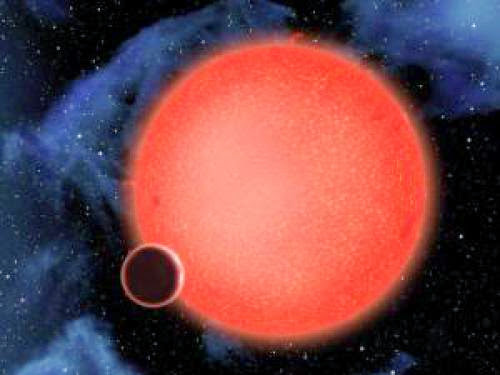Observations by NASA's Hubble Space Telescope have come up with a new class of planet, a waterworld enshrouded by a thick, steamy atmosphere. It's smaller than Uranus but larger than Earth.Zachory Berta of the Harvard-Smithsonian Center for Astrophysics (CfA) and colleagues made the observations of the planet GJ1214b."GJ1214b is like no planet we know of," Berta said. "A huge fraction of its mass is made up of water."The ground-based MEarth Project, led by CfA's David Charbonneau, discovered GJ1214b in 2009. This super-Earth is about 2.7 times Earth's diameter and weighs almost seven times as much. It orbits a red-dwarf star every 38 hours at a distance of 1.3 million miles, giving it an estimated temperature of 450 degrees Fahrenheit.In 2010, CfA scientist Jacob Bean and colleagues reported that they had measured the atmosphere of GJ1214b, finding it likely that it was composed mainly of water. However, their observations could also be explained by the presence of a planet-enshrouding haze in GJ1214b's atmosphere.Berta and his co-authors used Hubble's Wide Field Camera 3 (WFC3) to study GJ1214b when it crossed in front of its host star. During such a transit, the star's light is filtered through the planet's atmosphere, giving clues to the mix of gases."We're using Hubble to measure the infrared color of sunset on this world," Berta explained.Hazes are more transparent to infrared light than to visible light, so the Hubble observations help tell the difference between a steamy and a hazy atmosphere.They found the spectrum of GJ1214b to be featureless over a wide range of wavelengths, or colors. The atmospheric model most consistent with the Hubble data is a dense atmosphere of water vapor."The Hubble measurements really tip the balance in favor of a steamy atmosphere," Berta said.Since the planet's mass and size are known, astronomers can calculate the density, of only about 2 grams per cubic centimeter. Water has a density of 1 gram per cubic centimeter, while Earth's average density is 5.5 grams per cubic centimeter. This suggests that GJ1214b has much more water than Earth does, and much less rock.As a result, the internal structure of GJ1214b would be an extraordinarily different world than our world."The high temperatures and high pressures would form exotic materials like 'hot ice' or 'superfluid water,' substances that are completely alien to our everyday experience," Berta said.Theorists expect that GJ1214b formed farther out from its star, where water ice was plentiful, and migrated inward early in the system's history. In the process, it would have passed through the star's habitable zone, where surface temperatures would be similar to Earth's. How long it lingered there is unknown.GJ1214b is located in the direction of the constellation Ophiuchus, and just 40 light-years from Earth. Therefore, it's a prime candidate for study by the planned James Webb Space Telescope.Source



0 comments:
Post a Comment